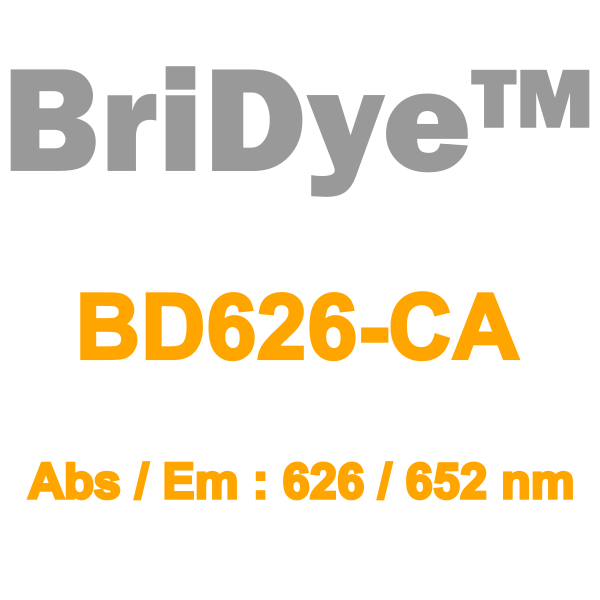 Image 1 of 1
Image 1 of 1


BD626-CA 100 stainings
BD626-CA is a bright, fluorogenic, cell permeable and red emitting ChloroAlkane (CA) substrate for Halo-tag™ labeling.
BD626-CA (also named BD626-HTL) is a ChloroAlkane (CA) derivative of the bridged-bicycle-strengthened red fluorophore BD615. The unique BriDye™ bicyclic ether bridge technology confers to BD626-CA an exceptional photostability. It emits light in the orange part of the UV-ViS spectrum, it is highly cell permeable and well suited for super resolution imaging.
BDBD626-CA absorption and emission maxima are 626 nm and 652 nm, respectively with an extinction coefficient of 130 000 M__ cm__ and a quantum yield of 0.81 (HT7 bound values). BD626-CA is highly cell-permeable, highly photostable, and compatible with e.g. 600/20 nm and 640/40 nm excitation and emission filters, respectively. BD626-CA is highly suited for widefield, confocal, SIM, or STED imaging in living or fixed specimens.
ChloroAlkane (CA) is the substrate of the self labeling tag Halo-tag™. Upon reaction with a CA derivative, Halo-tag™ forms a covalent bond with the substrate. It allows to permanently attach a fluorescent label to any protein of interest (POI) expressed as Halo-tag™ fusion.
Contains 1 vial of BD626-CA (10 nmol) in lyophilised form allowing to prepare 50 ul of 1000x DMSO stock solution (100 stainings).
BD626-CA is a bright, fluorogenic, cell permeable and red emitting ChloroAlkane (CA) substrate for Halo-tag™ labeling.
BD626-CA (also named BD626-HTL) is a ChloroAlkane (CA) derivative of the bridged-bicycle-strengthened red fluorophore BD615. The unique BriDye™ bicyclic ether bridge technology confers to BD626-CA an exceptional photostability. It emits light in the orange part of the UV-ViS spectrum, it is highly cell permeable and well suited for super resolution imaging.
BDBD626-CA absorption and emission maxima are 626 nm and 652 nm, respectively with an extinction coefficient of 130 000 M__ cm__ and a quantum yield of 0.81 (HT7 bound values). BD626-CA is highly cell-permeable, highly photostable, and compatible with e.g. 600/20 nm and 640/40 nm excitation and emission filters, respectively. BD626-CA is highly suited for widefield, confocal, SIM, or STED imaging in living or fixed specimens.
ChloroAlkane (CA) is the substrate of the self labeling tag Halo-tag™. Upon reaction with a CA derivative, Halo-tag™ forms a covalent bond with the substrate. It allows to permanently attach a fluorescent label to any protein of interest (POI) expressed as Halo-tag™ fusion.
Contains 1 vial of BD626-CA (10 nmol) in lyophilised form allowing to prepare 50 ul of 1000x DMSO stock solution (100 stainings).
